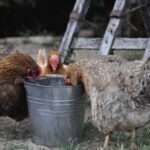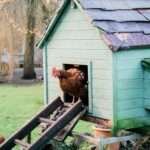Raising chickens comes with the responsibility of safeguarding your feathered friends during adverse weather conditions. Storms can present significant challenges to the health and safety of your flock, ranging from strong winds and heavy rain to potential flooding. As a responsible chicken keeper, it’s essential to be prepared and take proactive measures for caring for your chickens during a storm. In this article, we will explore the steps you can take to ensure the well-being of your flock when inclement weather threatens, providing them with the best care and support during challenging times.
Assessing Storm Threats and When to Take Action:
Before a storm arrives, it’s crucial to assess the potential risks it poses to your chickens and determine the appropriate level of action. Different types of storms, such as hurricanes, thunderstorms, or blizzards, can have varying impacts on your flock. Monitor weather forecasts and stay alert to warning signs indicating an incoming storm. Understanding storm severity and the safety of your chickens will help you decide when to take action and what preventive measures to implement.
Securing the Coop: Protecting Chickens from Wind, Rain, and Flooding:
One of the first steps in storm preparedness is securing the chicken coop to protect your feathered friends from the elements. Reinforce the coop structure to withstand strong winds and potential damage. Regularly inspect the coop for any weak points or areas susceptible to leaks. Ensuring proper drainage around the coop will help prevent flooding inside, which could be detrimental to the chickens’ health. Consider placing sandbags or barriers around the coop perimeter to divert water away during heavy rainfall.
Creating a Safe Indoor Enclosure for Your Flock:
In situations where the coop may not provide sufficient protection, having an indoor enclosure in your home can be a lifesaver for caring for your chickens during a storm. Assess available spaces, such as a large kitchen or bathroom, that can accommodate the entire flock for a day or longer if needed. Ensure the area is well-ventilated and provides adequate space for your chickens to move comfortably. Preparing in advance will help minimize stress on both you and your feathered companions when the time comes to relocate them to the indoor enclosure.

Preparing the Indoor Enclosure: Ensuring Comfort and Security:
Once you’ve selected the indoor enclosure, it’s essential to prepare it to accommodate the chickens’ needs. Lay down newspapers or plastic sheets to protect the indoor flooring from droppings and spills. Provide fresh bedding materials, such as straw or wood shavings, to ensure your chickens have a comfortable resting area. Additionally, consider setting up perches or roosts in the enclosure to mimic their coop environment and provide a sense of familiarity. Adequate ventilation is critical to maintain air quality and prevent moisture buildup, so make sure the enclosure is well-ventilated.
Stocking Up on Essential Supplies:
Having a well-prepared storm kit with essential supplies will help you weather the storm more effectively. Stock up on enough chicken feed, water, medications, and first aid items to last your flock through the storm. Consider having extra heat sources, such as heat lamps or heating pads, in case of power outages. Being prepared with necessary supplies will ensure that your chickens’ basic needs are met during the storm, even if you are temporarily unable to access their regular outdoor area.
Keeping Chickens Calm and Stress-Free:
During storms, chickens can become stressed and anxious due to the unfamiliar environment and weather conditions. Minimizing stress is essential for their well-being and overall health.
- Creating a Calm Environment: Playing soothing sounds or providing familiar objects, such as their favorite treats or toys, can help reduce stress in the indoor enclosure.
- Maintaining a Routine: Stick to your chickens’ regular feeding and watering schedule as much as possible to provide a sense of stability and routine.
- Monitoring Signs of Distress: Pay close attention to your chickens’ behavior during the storm. Signs of distress may include increased vocalization, restlessness, or changes in eating and drinking habits. Address any signs of distress promptly to ensure their comfort.
Coordinating with Local Authorities and Veterinarians:
Stay informed about local weather advisories and storm warnings issued by authorities. Follow evacuation orders if necessary, and have a communication plan in place with neighbors or fellow chicken keepers to ensure mutual support during emergencies. Reach out to your veterinarian or local poultry experts for advice and support on keeping chickens safe during storms. They can provide valuable guidance specific to your region and the type of storm you are facing.
Handling Power Outages and Backup Solutions:
Storms can often result in power outages, which can pose additional challenges for your flock. Having backup solutions in place will help you manage through such situations effectively.
- Backup Power Sources: Invest in portable generators or battery-operated heat lamps to provide warmth for your chickens if electricity is unavailable.
- Alternative Heating Methods: Explore other heating methods, such as hot water bottles or warm bricks wrapped in towels, to keep your chickens comfortable in the indoor enclosure.

Post-Storm Assessments and Recovery:
After the storm has passed, conduct a thorough post-storm check to assess any damage to the coop and surrounding area. Inspect the coop structure for any signs of damage or compromised integrity. Look for potential hazards like fallen branches or debris that may have accumulated around the coop. If you had to relocate your chickens to an indoor enclosure, take the time to clean and disinfect the area to maintain hygiene.
Learning from Experience: Improving Future Storm Preparedness:
Every storm experience provides an opportunity to learn and improve your preparedness for future events. Evaluate the effectiveness of your storm preparedness plan and identify areas for improvement. Take note of any lessons learned, such as specific challenges faced during the storm, and update your emergency plan accordingly. Sharing your experiences and knowledge with other chicken keepers can also contribute to building a supportive community of informed and prepared chicken enthusiasts.
Caring for Your Chickens During A Storm
Caring for your chickens during a storm requires proactive planning and a commitment to their safety and well-being. Assessing storm threats, securing the coop, creating a safe indoor enclosure, and stocking up on essential supplies are essential components of a robust storm preparedness plan. Keeping chickens calm and stress-free during inclement weather is crucial, and coordinating with local authorities and veterinarians can provide valuable support and guidance. Being prepared for power outages with backup solutions ensures your flock’s comfort and safety. After the storm, conducting thorough assessments and learning from the experience will strengthen your storm preparedness for future challenges. With these proactive measures in place, you can weather any storm while ensuring your chickens’ safety and preserving the bond between you and your beloved feathered companions.






